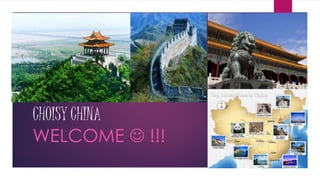This document provides an overview of ancient Chinese civilization. It covers topics such as the major dynasties that ruled (Shang, Zhou, Qin, Han), geography (rivers, mountains), cities and architecture (Forbidden City, pagodas), art forms (calligraphy, silk, porcelain), inventions (paper, printing, gunpowder), and the economy (silk road trade). It also discusses the social hierarchy, religious beliefs, and the eventual decline of ancient Chinese civilization after the fall of the Han dynasty due to internal turmoil and external invasions.




















![Ancient pagodas
A pagoda is a tiered tower with multiple eaves, built in traditions originating
in historic East Asia or with respect to those traditions, common
to Nepal, India, China, Japan, Korea, Vietnam, Burma and other parts of
Asia. Some pagodas are used as Taoist houses of worship. Most pagodas
were built to have a religious function, most commonly Buddhist, and were
often located in or near viharas. In some countries, the term may refer to
other religious structures. In Vietnam and Cambodia, due to French
translation, the English term
Pagoda is a more generic term referring to a place of worship,
although pagoda is not an accurate word to describe a Buddhist vihara.
The modern pagoda is an evolution of the Ancient Nepal stupa, a tomb-like
structure where sacred relics could be kept safe and venerated.[1] The
architectural structure of the stupa has spread across Asia, taking on many
diverse forms as details specific to different regions are incorporated into
the overall design](https://image.slidesharecdn.com/ancientchina-150103215011-conversion-gate02/85/Ancient-china-Civilization-21-320.jpg)










